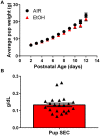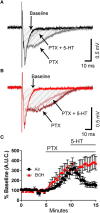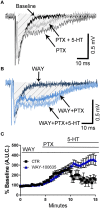Third Trimester Equivalent Alcohol Exposure Reduces Modulation of Glutamatergic Synaptic Transmission by 5-HT1A Receptors in the Rat Hippocampal CA3 Region
- PMID: 27375424
- PMCID: PMC4896948
- DOI: 10.3389/fnins.2016.00266
Third Trimester Equivalent Alcohol Exposure Reduces Modulation of Glutamatergic Synaptic Transmission by 5-HT1A Receptors in the Rat Hippocampal CA3 Region
Abstract
Fetal alcohol exposure has been associated with many neuropsychiatric disorders that have been linked to altered serotonin (5-hydroxytryptamine; 5-HT) signaling, including depression and anxiety. During the first 2 weeks of postnatal life in rodents (equivalent to the third trimester of human pregnancy) 5-HT neurons undergo significant functional maturation and their axons reach target regions in the forebrain (e.g., cortex and hippocampus). The objective of this study was to identify the effects of third trimester ethanol (EtOH) exposure on hippocampal 5-HT signaling. Using EtOH vapor inhalation chambers, we exposed rat pups to EtOH for 4 h/day from postnatal day (P) 2 to P12. The average serum EtOH concentration in the pups was 0.13 ± 0.04 g/dl (legal intoxication limit in humans = 0.08 g/dl). We used brain slices to assess the modulatory actions of 5-HT on field excitatory postsynaptic potentials in the hippocampal CA3 region at P13-P15. Application of the GABAA/glycine receptor antagonist, picrotoxin, caused broadening of field excitatory postsynaptic potentials (fEPSPs), an effect that was reversed by application of 5-HT in slices from air exposed rats. However, this effect of 5-HT was absent in EtOH exposed animals. In slices from naïve animals, application of a 5-HT1A receptor antagonist blocked the effect of 5-HT on the fEPSPs recorded in presence of picrotoxin, suggesting that third trimester ethanol exposure acts by inhibiting the function of these receptors. Studies indicate that 5-HT1A receptors play a critical role in the development of hippocampal circuits. Therefore, inhibition of these receptors by third trimester ethanol exposure could contribute to the pathophysiology of fetal alcohol spectrum disorders.
Keywords: fetal alcohol spectrum disorders; fetal alcohol syndrome; hippocampus; rat model; serotonin; synaptic transmission.
Figures




Similar articles
-
Ethanol exposure during the third trimester equivalent does not affect GABAA or AMPA receptor-mediated spontaneous synaptic transmission in rat CA3 pyramidal neurons.J Negat Results Biomed. 2015 Dec 2;14:19. doi: 10.1186/s12952-015-0041-9. J Negat Results Biomed. 2015. PMID: 26627643 Free PMC article.
-
Third trimester-equivalent ethanol exposure does not alter complex spikes and climbing fiber long-term depression in cerebellar Purkinje neurons from juvenile rats.Alcohol Clin Exp Res. 2014 May;38(5):1293-300. doi: 10.1111/acer.12362. Epub 2014 Apr 1. Alcohol Clin Exp Res. 2014. PMID: 24689500 Free PMC article.
-
Effects of third trimester-equivalent ethanol exposure on Cl(-) co-transporter expression, network activity, and GABAergic transmission in the CA3 hippocampal region of neonatal rats.Alcohol. 2012 Sep;46(6):595-601. doi: 10.1016/j.alcohol.2012.04.003. Epub 2012 Jun 14. Alcohol. 2012. PMID: 22703993 Free PMC article.
-
Moderate Alcohol Exposure during the Rat Equivalent to the Third Trimester of Human Pregnancy Alters Regulation of GABAA Receptor-Mediated Synaptic Transmission by Dopamine in the Basolateral Amygdala.Front Pediatr. 2014 May 27;2:46. doi: 10.3389/fped.2014.00046. eCollection 2014. Front Pediatr. 2014. PMID: 24904907 Free PMC article.
-
AMPAR-mediated synaptic transmission in the CA1 hippocampal region of neonatal rats: unexpected resistance to repeated ethanol exposure.Alcohol. 2009 Dec;43(8):619-25. doi: 10.1016/j.alcohol.2009.10.004. Alcohol. 2009. PMID: 20004339 Free PMC article.
Cited by
-
Prenatal and postnatal insults differentially contribute to executive function and cognition: Utilizing touchscreen technology for perinatal brain injury research.Exp Neurol. 2022 Aug;354:114104. doi: 10.1016/j.expneurol.2022.114104. Epub 2022 May 4. Exp Neurol. 2022. PMID: 35525306 Free PMC article.
-
Ethanol induced antidepressant-like effect in the mouse forced swimming test: modulation by serotonergic system.Psychopharmacology (Berl). 2017 Feb;234(3):447-459. doi: 10.1007/s00213-016-4478-4. Epub 2016 Nov 12. Psychopharmacology (Berl). 2017. PMID: 27838747
References
-
- Boulle F., Pawluski J. L., Homberg J. R., Machiels B., Kroeze Y., Kumar N., et al. (2015). Prenatal stress and early-life exposure to fluoxetine have enduring effects on anxiety and hippocampal BDNF gene expression in adult male offspring. Dev. Psychobiol. 58, 427–438. 10.1002/dev.21385 - DOI - PubMed
Grants and funding
LinkOut - more resources
Full Text Sources
Other Literature Sources
Miscellaneous

